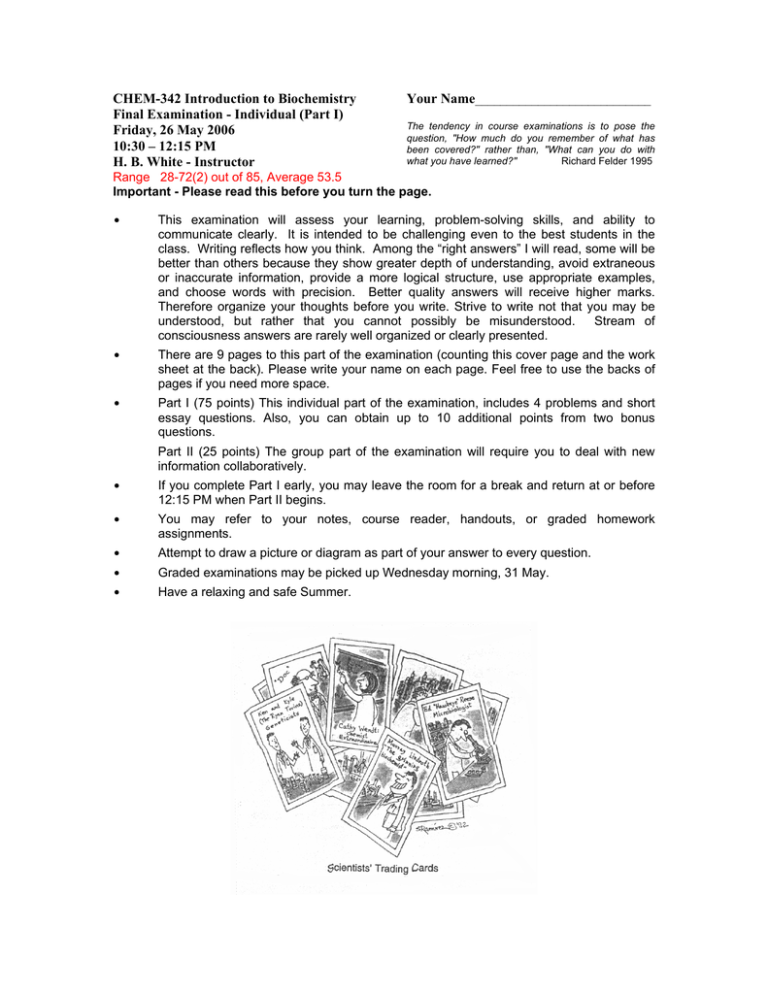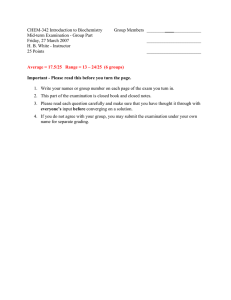Document 10460899
advertisement

CHEM-342 Introduction to Biochemistry Final Examination - Individual (Part I) Friday, 26 May 2006 10:30 – 12:15 PM H. B. White - Instructor Your Name____________________________ The tendency in course examinations is to pose the question, "How much do you remember of what has been covered?" rather than, "What can you do with what you have learned?" Richard Felder 1995 Range 28-72(2) out of 85, Average 53.5 Important - Please read this before you turn the page. $ This examination will assess your learning, problem-solving skills, and ability to communicate clearly. It is intended to be challenging even to the best students in the class. Writing reflects how you think. Among the “right answers” I will read, some will be better than others because they show greater depth of understanding, avoid extraneous or inaccurate information, provide a more logical structure, use appropriate examples, and choose words with precision. Better quality answers will receive higher marks. Therefore organize your thoughts before you write. Strive to write not that you may be understood, but rather that you cannot possibly be misunderstood. Stream of consciousness answers are rarely well organized or clearly presented. $ There are 9 pages to this part of the examination (counting this cover page and the work sheet at the back). Please write your name on each page. Feel free to use the backs of pages if you need more space. $ Part I (75 points) This individual part of the examination, includes 4 problems and short essay questions. Also, you can obtain up to 10 additional points from two bonus questions. Part II (25 points) The group part of the examination will require you to deal with new information collaboratively. $ If you complete Part I early, you may leave the room for a break and return at or before 12:15 PM when Part II begins. $ You may refer to your notes, course reader, handouts, or graded homework assignments. $ Attempt to draw a picture or diagram as part of your answer to every question. $ Graded examinations may be picked up Wednesday morning, 31 May. $ Have a relaxing and safe Summer. CHEM-342 Introduction to Biochemistry Final Examination Individual Part, 26 May 2006 1. Your Name ____________________________________ Page 2 (43 points total) This problem has a number of parts in which you will apply what you have learned about protein structure and synthesis from the Pauling et al., Ingram, and Dintzis articles as well as your hemoglobinopathy assignment. When Dintzis published his first paper on the direction of protein synthesis, the amino acid sequence of hemoglobin was not known from any organism. He made the presumption that the labeled peptides he observed could be ordered in sequence by their increasing 3H/14C ratios. Soon after the sequence of human (not rabbit) hemoglobin was determined. Dintzis, with Naughton, published a second paper because the previous paper did not “constitute a rigorous proof of the sequential assembly of amino acids into hemoglobin.” Now the sequence of rabbit hemoglobin is known. It is aligned and displayed with human hemoglobin below. (You will be marking up this figure for your answer. Please tear off the last page of this exam and use it as a worksheet.) Alpha Chain Globins 10 20 30 40 VLSPADKTNIKTAWEKIGSHGGEYGAEAVERMFLGFPTTKTY→ VLSPADKTNVKAAWGKVGAHAGEYGAEALERMFLSFPTTKTY→ RABBIT HUMAN 50 60 70 80 90 FPHFDFTHGSEQIKAHGKKVSEALTKAVGHLDDLPGALSTLSDLHAHKLR→ FPHFDLSHGSAQVKGHGKKVADALTNAVAHVDDMPNALSALSDLHAHKLR→ 100 110 120 130 141 VDPVNFKLLSHCLLVTLANHHPSEFTPAVHASLDKFLANVSTVLTSKYR VDPVNFKLLSHCLLVTLAAHLPAEFTPAVHASLDKFLASVSTVLTSKYR Beta Chain Globin 10 20 30 40 RABBIT VHLSSEEKSAVTALWGKVNVEEVGGEALGRLLVVYPWTQRFFES→ HUMAN VHLTPEEKSAVTALWGKVNVDEVGGEALGRLLVVYPWTQRFFES→ 50 60 70 80 90 FGDLSSANAVMNNPKVKAHGKKVLAAFSEGLSHLDNLKGTFAKLSELHCDK→ FGDLSTPDAVMGNPKVKAHGKKVLGAFSDGLAHLDNLKGTFATLSELHCDK→ 100 110 120 130 140 146 LHVDPENFRLLGNVLVIVLSHHFGKEFTPQVQAAYQKVVAGVANALAHKYH LHVDPENFRLLGNVLVCVLAHHFGKEFTPPVQAAYQKVVAGVANALAHKYH The single-letter abbreviations for the 20 amino acids are: A C D E F G H = = = = = = = Alanine Cysteine Aspartic Acid Glutamic Acid Phenylalanine Glycine Histidine Questions on next page I K L M N P Q = = = = = = = Isoleucine Lysine Leucine Methionine Asparagine Proline Glutamine R S T V W Y = = = = = = Arginine Serine Threonine Valine Tryptophan Tyrosine CHEM-342 Introduction to Biochemistry Final Examination Individual Part, 26 May 2006 Your Name ____________________________________ Page 3 1. (continued) Pay attention to detail. a. (4 points) Using a vertical line between letters to indicate peptide bond hydrolysis, identify all of places in the rabbit and human alpha and beta globin chains that are susceptible to trypsin hydrolysis. b. (6 points) Identify one trypsin-susceptible peptide bond by chain/number and draw the structure of the dipeptide that includes it. c. (4 points) Draw a box around every rabbit tryptic peptide that would contain radioactivity in Dintzis’ experiment. d. (2 points) Draw a line under every amino acid that is different in the human alpha and beta globins compared to the homologous rabbit sequences. e. (6 points) Using the standard genetic code on the yellow cards you have been given, identify with a star under those differences in part 1d that would require more than a one-base change in a codon. f. (6 points) How many sulfur atoms per iron atom are there in: Human hemoglobin? Rabbit hemoglobin? S/Fe = S/Fe = Referring to your answers to 1a & 1c the previous section: g. (5 points) Do you find any discrepancies between your analysis and what Dintzis reported in his first paper? If so, describe. CHEM-342 Introduction to Biochemistry Final Examination Individual Part, 26 May 2006 Your Name ____________________________________ Page 4 h. (10 points) Many of the hemoglobinopathies studied by students in CHEM342 involve a single base change in a codon resulting in a single amino acid substitution in the alpha or beta globin chain. Comparing human and rabbit hemoglobins there are many amino acid differences in both chains, yet the hemoglobins are functionally very similar. How is it possible that a single amino acid substitution can have such a devastating effect within a species while the many differences between rabbit and human hemoglobins have no apparent detrimental effects? CHEM-342 Introduction to Biochemistry Final Examination Individual Part, 26 May 2006 Your Name ____________________________________ Page 5 2. (10 points) Electrophoresis of Human Hemoglobin Variants – ↓ + Sample HbA HbA/S HbS HbA/X HbX/S HbS HbA/S HbA The figure at the left shows the cellulose acetate electrophoretic pattern of blood samples from humans with different hemoglobin genotypes as they were separated at pH 8.5 for 15 minutes. The vertical dashed line below the arrow is the origin where the samples were initially applied. Describe what you observe. Based on what you know about HbS and HbA from the Pauling et al. and Ingram articles, what can you deduce about the nature of the amino acid replacement in HbX? Consider as many possibilities that are consistent with the observed patterns. CHEM-342 Introduction to Biochemistry Final Examination Individual Part, 26 May 2006 Your Name ____________________________________ Page 6 3. Essay (10 points) Mahlon Hoagland, discoverer of mRNA, is in some ways like Howard Dintzis in that he discovered something of considerable importance but is largely unknown. In his autobiography, Hoagland said the following about science, Science is a process, a progression, because its discoveries are cumulative, the stories of an edifice under construction. Dintzis, in his visit to our class, also offered some gems of wisdom about science. Based on Hoagland’s quotation and/or something Dintzis said during his visit, reflect on the articles we have studied since Spring Break and put them into some unifying context in a short essay. CHEM-342 Introduction to Biochemistry Final Examination Individual Part, 26 May 2006 Your Name ____________________________________ Page 7 4. Biochemical Sudoku (12 points) The fact that nitrogen from 15N-labeled glycine was incorporated in such high amounts into heme clearly indicated that, unexpectedly, glycine was a biosynthetic precursor of heme. After this initial experiment designed to study protein turnover, Shemin’s interest understandably shifted to the biosynthesis of heme. Rather than continuing to experiment on himself, he chose to work with duck red blood cells because, unlike mammalian red blood cells, they were nucleated and thus continued to synthesize heme after differentiation. Shemin’s experiments with Rittenberg showed that the nitrogen atom from glycine was incorporated into heme, but the experiment provided no evidence for the incorporation of carbon atoms from glycine into heme, an experiment that became possible with 14C. When 15NH2-14CH2-COOH was used as a heme precursor, instead of the anticipated 1:1 incorporation of labeled nitrogen and labeled carbon, they found two atoms of 14C per atom of 15N in heme. Other experiments showed that the carboxyl group of glycine was not incorporated at all into heme or into δaminolevulinic acid (δ-ALA), an intermediate on the pathway to heme outlined below. CH2 HC C COO X H3C Z C COO H315N 14 CH2 Glycine N CH2 CH N C C C C C C H2C C H OOC CH3 C CH2 Heme CH2 C H C N NH3 delta ALA C Fe C H3C N HC O CH2 C C C a series of enzyme reactions C C CH2 CH2 CH3 H C H2C COO a. (4 points) In the space below, make an educated guess at the chemical structures of X and Z based on the information provided. Explain your reasoning. Parts b and c on the next page. CHEM-342 Introduction to Biochemistry Final Examination Individual Part, 26 May 2006 Your Name ____________________________________ Page 8 b. (8 points) Predict which carbon atoms in heme are derived from the 14Clabelled methylene carbon in glycine? Circle each. What is the basis of your deduction? . c. (5 point bonus) Predict the 15N/14C ratio in heme biosynthesized from doubly labeled [1-14C, 5-15N] δ-aminolevulinic acid. (Do not spend time on this problem unless you finish early with the rest of the examination or feel you really have a good idea of what is going on in part b.) 5. (5 point bonus) You were asked to attend at least two research seminars this semester. Describe one of them and one thing that you remember from the seminar. CHEM-342 Introduction to Biochemistry Final Examination Individual Part, 26 May 2006 Your Name ____________________________________ Page 9 Worksheet for Problem 1. Can be removed. Alpha Chain Globins 10 20 30 40 VLSPADKTNIKTAWEKIGSHGGEYGAEAVERMFLGFPTTKTY→ VLSPADKTNVKAAWGKVGAHAGEYGAEALERMFLSFPTTKTY→ RABBIT HUMAN 50 60 70 80 90 FPHFDFTHGSEQIKAHGKKVSEALTKAVGHLDDLPGALSTLSDLHAHKLR→ FPHFDLSHGSAQVKGHGKKVADALTNAVAHVDDMPNALSALSDLHAHKLR→ 100 110 120 130 141 VDPVNFKLLSHCLLVTLANHHPSEFTPAVHASLDKFLANVSTVLTSKYR VDPVNFKLLSHCLLVTLAAHLPAEFTPAVHASLDKFLASVSTVLTSKYR Beta Chain Globin 10 20 30 40 RABBIT VHLSSEEKSAVTALWGKVNVEEVGGEALGRLLVVYPWTQRFFES→ HUMAN VHLTPEEKSAVTALWGKVNVDEVGGEALGRLLVVYPWTQRFFES→ 50 60 70 80 90 FGDLSSANAVMNNPKVKAHGKKVLAAFSEGLSHLDNLKGTFAKLSELHCDK→ FGDLSTPDAVMGNPKVKAHGKKVLGAFSDGLAHLDNLKGTFATLSELHCDK→ 100 110 120 130 140 146 LHVDPENFRLLGNVLVIVLSHHFGKEFTPQVQAAYQKVVAGVANALAHKYH LHVDPENFRLLGNVLVCVLAHHFGKEFTPPVQAAYQKVVAGVANALAHKYH The single-letter abbreviations for the 20 amino acids are: A C D E F G H = = = = = = = Alanine Cysteine Aspartic Acid Glutamic Acid Phenylalanine Glycine Histidine I K L M N P Q = = = = = = = Isoleucine Lysine Leucine Methionine Asparagine Proline Glutamine R S T V W Y = = = = = = Arginine Serine Threonine Valine Tryptophan Tyrosine




